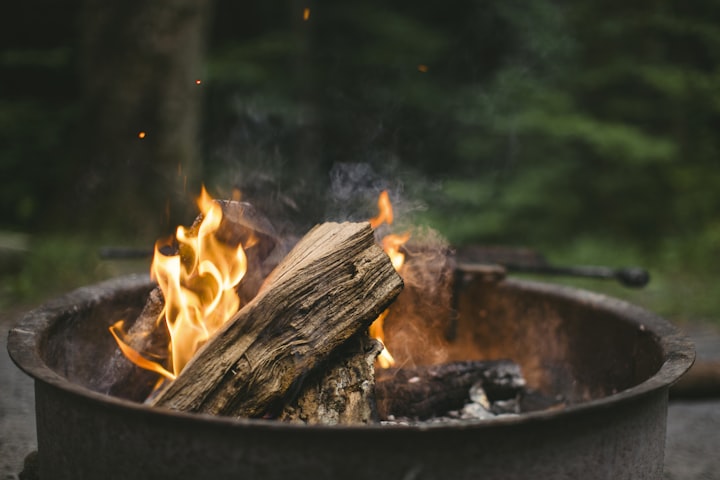Five Tips for Fire Lighting in Your Garden.
Look after your firepit or chiminea for the best fire-lit outdoor experience.

Gardens are a place for social gatherings – for sharing memories, food, and warmth around a fire. A firepit or chiminea can liven up any outdoor space. However, they need to be cleaned out regularly and maintained once every couple of months, even during winter. Here's what you need to know in order to get the most out of your outdoor wood-burning appliances.
1) Choose a high-quality solid fuel:
Finding the best quality fuel for your appliance will keep it in great condition for longer. Kiln dried firewood produces less ash and less smoke, which will make sitting in the garden a much more pleasant experience.
Stuart Fitzgerald, the managing director of UK firewood company White Horse Energy, explains why seeking quality above all else should be your priority. Fitzgerald states that “Using high quality fuels will ensure that you can run your appliance at the 'correct' rate and not risk overheating by unintentionally overloading it". He also explained that higher quality fuels produce less ash, which is necessary when considering a fuel’s burn characteristics (see point 3 to discover why removing ash is important).
Firewood isn’t the only fuel you can use. Briquettes are a great alternative – they're made from compressed wood waste and work well in iron firepits and chimineas. Look out for the ‘Ready to Burn' label at point of sale - this will tell you that your wood fuel is quality checked and has a moisture content of under 20%. (Please note: this label isn’t present on volumes over 2m3.)
2) Avoid moisture of any kind:
Use waterproof covers between uses otherwise rain will cause structural damage, affect fire lighting or reduce the heat output. If moisture seeps into your fuel, it won’t burn effectively and will produce more smoke. Store fuel out of the rain and off the ground and make sure appliances are completely dry before the next use. The drier the fuel, the cleaner and hotter the burn.
When you’re done, wait for the fire to die on its own instead of putting it out with water. Sudden drops in temperature can cause cracks or warping in appliances.
3) Remove all ash and fuel from appliances:
Ash continues producing heat hours after the fire gets put out, and It's not worth causing accidents by being impatient! Let surfaces and the fire remains completely cool down first. Burned fuel cannot be reused, so dispose of this next. Then, remove ash carefully with a brush and fireproof bucket. Ash causes corrosive damage to the structure due to its acidity, while also accumulating moisture which causes rust. This is why cleaning out after each use is important.
4) Clean and protect your appliance:
Metal firepits and chimineas can be washed out with water and soap. Rubbing oil around steel surfaces every few weeks will protect the condition and give your appliance an extra shine.
Cast iron firepits require a bit more care; they’re excellent for handling high temperatures produced by briquettes but are prone to rusting. Use a steel wool brush to remove rust, then add a protective barrier coating to prevent any from forming.
For masonry and stone firepits, use a scrubbing brush and a cleaning solution such as dishwasher soap or a solution of 8 parts water to 1-part muriatic acid for tough stains. You must wear protective gloves when handling muriatic acid, and rinse off the solution with water afterwards.
Clay chimineas are traditional and the more decorative choice. Fired clay is porous, so apply a sealant to the exterior once a month to protect it from moisture. Because clay is more likely to crack, it’s vital to build the temperature more gradually by using smaller amounts of fuel (avoid charcoal as it burns too hot for clay).
5) Extra tips for BBQs and pizza ovens.
Barbecues and pizza ovens are in no way intended for decoration, but if not cleaned and protected from the elements they could soon become an eyesore. Before cleaning either of them, turn the heat up high to burn off food remains.
Remove the grate on BBQs and close the lid or vents to completely extinguish the fire, then wait 12 – 48 hours for charcoal to cool down before disposing of it. To clean, use a soft cloth and barbecue cleaning liquid. Don't use an abrasive sponge or a scour - this will damage ceramic or metal surfaces.
In pizza ovens, you need to clean the interior daily and remove food spills using long bristled brushes and damp cloths. Don’t use any cleaning liquids at risk of chemicals getting into your food. Sweep the small chimney once a month and clean the pizza stone separately once a week (scrub gently to avoid scratching). Add a few layers of a waterproof sealant at least once per year.
A little bit of care goes a long way, and with this information, your outdoor living space will become much more relaxing. You can’t have a well-maintained garden without also showing your firepit or chiminea the love it deserves.
About the Creator
Lauren Oakly
Freelance content + copywriter.
I'm slightly obsessed with obtaining grammatical perfection - great for my professional life, not so great for my social life!






Comments
There are no comments for this story
Be the first to respond and start the conversation.